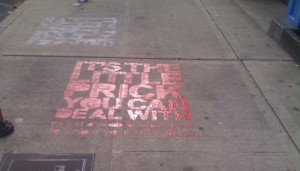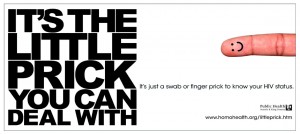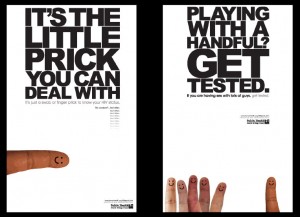A couple of years ago, as I rode home from work on the bus, I found myself twisting in my seat. “Did I just see what I thought I saw?”
I laughed out loud. Hilarious. My next thought was, “What is this?” Looking more closely, I found the call to action. “This is brilliant. Are they allowed to do this?”
I was in the early days of my career in public health. I was researching campaigns around physical fitness, climate change, parenting, pedestrian safety, and STDs, but I had never come across a campaign like this.
The billboard I saw was part of a campaign being run by Public Health – Seattle & King County (PHSKC), the health department in Seattle. They had received funding to address HIV/AIDS in Seattle, and their research had indicated that the highest risk population in Seattle were men having sex with men, mostly in their 20s and 30s, living in the Capitol Hill neighborhood.
PHSKC began convening groups of men in the target group to evaluate messages around HIV and AIDS. The resounding message was “Don’t tell us about condoms. We know about condoms. Oh, and whatever you do, it would be cool if it was funny.” PHSKC was listening. Eventually, PHSKC landed on messaging around a more convenient way for testing that only required a small “prick” of the finger or a mouth swab.
With the audience defined and the call for action determined, now PHSKC needed to figure out the creative. What would their visual and written messaging be? And what would they use for dissemination? After a couple of ideas that did not resonate with the audience, “Little Prick” was born.
“Little Prick” was highly effective. The campaign ran throughout the Capitol Hill neighborhood on billboards and chalked onto sidewalks. Coasters wound their way into pubs and bars. HIV/AIDS testing continued to increase throughout the campaign.
But the campaign wasn’t run without some caution flags. PHSKC, afterall, is a governmental organization that wanted to save lives by preventing HIV/AIDS infections without angering other voting, tax-paying constituents.
PHSKC held meetings throughout the neighborhood, particularly if there was a billboard going up nearby. They told businesses and residents about the campaign, its purpose, and what it would say. The prepared internally for angry calls, upset citizens, and potential city outcry. PHSKC was completely prepared, but apparently, so was the city. Not one angry citizen called. Not one upset individual voiced concern.
 |
| Sidewalk chalk outside pubs in Seattle's Capitol Hill |
The “Little Prick” campaign demonstrates dedicated public health professionals working to reduce risk and illness. They listened to the target audience and worked with the community to explain what was happening to develop support for an initiative. Afterall, public health is responsible for the health of all people, not just the non-controversial, politically safe health issues.
I have presented the “Little Prick” campaign in a number of speeches and trainings for public health departments. One woman from Wyoming once told the class, “This would never work with my citizens, not even my gay men in their 20s and 30s.” That’s the point. It’s creative and effective because this campaign knows its audience and audiences are not the same. What works in Seattle may not work in Wyoming. Find out about your audience, find ways to get them the message where they are, make that message meaningful, and you’ll have a powerful campaign.



No comments:
Post a Comment